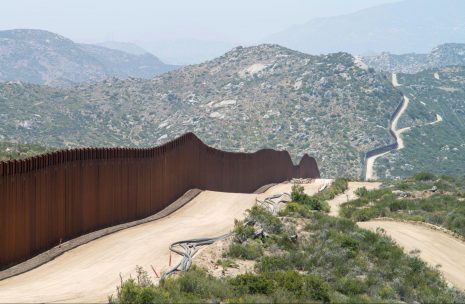What changes to immigration did Trump make in his first presidency?
The Trump administration set a record for administrative action on immigration, completing more than 450 executive actions. Approximately 20% of these actions impacted the agencies responsible for overseeing legal immigration – the United States Citizenship and Immigration Services (“USCIS”) and the Department of Labor (“DOL”). Among other things, these actions required that foreign nationals provide more documentation before obtaining an extension of their status or permanent residency, coinciding with a 17% decrease in applications in 2019 and a 22% decrease in 2020 as compared to 2016.
However, the most widely known Trump policies occurred at the southern border with Mexico. 2019 had the highest number of migrant apprehensions at the southern border since 2007. A new policy was enacted to make asylum seekers ineligible for asylum in the U.S. if they didn’t apply for asylum elsewhere on their way to the U.S. border. The Migrant Protection Protocols were expanded to require all migrants, including asylum seekers, to wait in Mexico for their U.S. court date. In March of 2020, the Trump administration invoked Title 42, closing the southern border to asylum seekers to control the spread of COVID-19. Between 2016 and 2020, the number of cases adjudicated in immigration court rose by 61% and the number of deportation orders rose by 102%. Finally, in 2018, the Trump administration allowed the fewest number of refugee admissions in modern history, approximately 22,000 refugees compared to approximately 85,000 in 2016.

Photo by Greg Bulla on Unsplash
What are Trump’s immigration goals for a second term?
Trump has stated on the campaign trail that he wants to reinstate certain policies from his first term, including restricting immigration from Muslim-majority countries and invoking Title 42 to limit asylum seekers. His stated goal is to deport unauthorized immigrants in the millions per year, which he will accomplish by expanding the number of removal orders that don’t require a court hearing and by reassigning federal agents to work with Immigration and Customs Enforcement (“ICE”). Trump will build large detainment camps to hold immigrants while they await either a court hearing or a flight out of the U.S., using the military budget to accomplish this.
Trump also has several policies aimed at limiting legal immigration. He has stated that he would cancel student visas for individuals who participate in anti-Israel or pro-Palestine protests. He would direct consular officers abroad to evaluate the ideological leanings of visa applicants and reject those who have “undesirable attitudes.” Trump would also revoke temporary protected status (“TPS”). TPS is granted to individuals from certain countries that have been deemed unsafe by the Department of Homeland Security (“DHS”). As of March 2023, there are approximately 600,000 individuals in the U.S. on TPS from 16 countries. Finally, he would seek to end birthright citizenship for individuals born in the U.S. to unauthorized parents.
How will Trump implement these policies without being stopped by a court?
The Trump administration will likely push for new legislation from Congress, but is not relying on new legislation for their immigration plans. All of the steps being prepared during the campaign rely on existing laws that have been unused for decades.
The campaign has also acknowledged the likelihood that all of Trump’s policies will be challenged in court, but it has stated the strategy is to deploy a “blitz” of new immigration policies to overwhelm immigration and constitutional attorneys. Additionally, Trump’s first presidency left behind a more conservative Court of Appeals and Supreme Court, which will likely be more willing to accept Trump’s immigration policies.
Finally, Trump will rely on changing American opinions related to immigration. The end of COVID-19 and the return to travel have led to ever-increasing flows of migrants to the U.S. southern border. Millions of Venezuelans and Central Americans are fleeing political turmoil and millions of Africans are arriving in Latin America to travel north into the U.S. American voters are frustrated with the current system and even those on the left are calling for stricter immigration controls at the border. If elected, Trump will capitalize on this atmosphere.

Photo by Sam Xu on Unsplash
But the H-1B visa program is arguably the most important method for bringing skilled work to the U.S. Is Trump going to restrict H-1Bs too?
Based on the Trump administration’s treatment of H-1B status holders in his first term, employers and foreign nationals should expect new restrictions on hiring an individual in H-1B status. The denial rate for H-1B petitions seeking initial employment reached 24% in 2018 and dropped only slightly to 21% in 2019. A legal settlement in 2020 forced USCIS to stop certain restrictive practices, causing denial rates to drop to 2% by 2022. At the same time, the denial rate for H-1B petitions seeking an extension of status reached 12% in both 2018 and 2019. These petitions were largely filed for foreign nationals who had not changed employers. Again, this declined to 2% by 2022. Expect denial rates to rise in a second Trump presidency.
Additionally, the Trump administration previously attempted to publish several restrictive rules surrounding H-1B petitions, which were ultimately prevented from going into effect due to lawsuits. Among these rules were (1) narrowing the definition of “specialty occupation” and “employer-employee relationship;” (2) reducing the validity of an H-1B approval to one year for foreign nationals who work at customer locations; and (3) increasing the required minimum wage by over 50% of the market wage. Any or all of these could be pursued in a second term.
What would be the impact of these restrictions on H-1Bs?
Research shows these restrictions will cause companies to send jobs, resources, and innovations abroad. For most global multinational companies, this is a 1-to-1 exchange, meaning restrictive immigration policies would seriously harm American competitiveness.
Zulkie Partners will continue to monitor the Trump campaign’s immigration plans and will post changes as they happen.